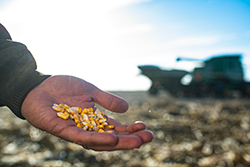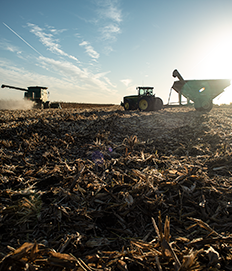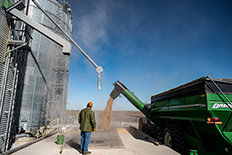Consider These 4 Strategic Tips to Prepare Your Grain Market Strategy


You spend all season focused on your crops, from selecting seeds to developing protection strategies. But how much time do you spend developing your grain marketing strategy? A strong marketing plan can help growers move from reacting to the whims of the market to implementing proactive controls for pricing risk.
Grain marketing involves a complex network of decisions, and the sometimes math-intensive nature of grain marketing can be challenging. However, grain markets typically follow general trends in terms of both supply/demand and pricing. Growers with a clear marketing plan can monitor and respond effectively to the variables that influence price, including the South American grain harvest, U.S. weather trends, and changing trade relationships.
Creating a written grain marketing strategy makes it easier to evaluate different scenarios in play—from changing price points to late-breaking contract opportunities—and can help you find the right solution for your goals and individual needs. Let’s take a closer look at the elements of an effective grain market strategy and considerations when planning for the year ahead.
Taking stock of what you expect to have on hand to sell—and the profit you need to make on it—are likely the first steps in developing your grain marketing strategy. Begin with calculating your actual production harvest (APH) per acre. APH takes into account historical actuals data to calculate the yield that you’ve produced per acre over a period of up to 10 years. Factors such as new crop genetics, better technology, and improved cultural practices may shift the balance in your favor, but APH represents a tried and true, conservative approach to determine what you’re likely to produce in a given season.
From there, assess your total cost per acre. Depending on when you plan to sell, this will include your pre-harvest inputs such as seed and crop protection, labor, equipment, and other costs. It may also be important to look at post-harvest storage costs and interest if you’re selling later in the season.
With this information in mind, it’s possible to calculate your break-even point and understand exactly what prices you need to be profitable. The five-year average for soybean harvest is about 49.5 bushels per acre, based on data from the Pro Farmer Crop Tour. So if you’ve spent $500,000 over the course of a season on 1,000 acres, for example, you would need to generate around $10.10 per bushel to break even. How much profit do you want to see on top of that? Selling for $11 per bushel in this scenario would offer a profit of $44,500.
Knowing your APH and target revenue can help you do two things. First, it helps you develop a crop insurance strategy. Crop insurance policies offer differential payments if you come in under yield or revenue projections. Policies are typically written using your APH and the futures market, which looks at the anticipated price of your crop in the year ahead. Getting a crop insurance plan in place is a cornerstone of your larger financial and risk planning.
Understanding the target price you need to break even also provides you with an objective benchmark. Building your marketing plan around the numbers needed to operate your farm helps you remove the emotion from decision-making. Instead, you always have a baseline metric to help you decide whether to sell your grain or hold for another day.
How you price your grain determines how profitable you are. Once you have a profitable price target in place, you can decide how best to stagger sales. Breaking your harvest up into multiple sales throughout the year can potentially increase profitability and mitigate risk.
Grain prices are established at two different, but related, markets. The first is the futures market, which anticipates supply and demand in the larger market based on the Chicago Board of Trade. A future is a contract for later delivery, specifying the date, location, amount and grade of the crop.
Typically, a futures price is established for each month throughout the year and then changes as the realities of the market unfold. After a lackluster summer in 2020, for example, a derecho stretching from Nebraska to Indiana damaged millions of acres of farmland and drove up prices dramatically. Futures indicate market direction, but they’re subject to what’s happening in the field.
The second factor in pricing is the cash market, or the price for a bushel of grain at the local grain elevator today. The variance between the futures price and the local cash market price is called basis. The cash price for grain is typically the futures price plus the basis.
Watching the basis can give you insights into market health; in fact, Farm Progress calls basis the “voice of the market.” For growers, a narrow basis suggests that there’s more demand than supply. A widening basis flips that perspective and suggests that today there’s less demand for your grain than there is supply. Tracking the market pulse helps you time your sales.

Selling early -- at harvest -- means that you may be competing with significant supply as other growers rush their product to market. However, you’re also eliminating post-harvest costs such as storage and interest expense. This is why it’s important to have both pre-harvest and post-harvest marketing plans in place.
With pre-harvest marketing, growers determine the insurance coverage they need and what will be sold at harvest to help cover costs and replenish cash flow. Post-harvest marketing establishes target pricing and contract styles, along with deadlines for pricing grains and deadlines for selling stored product.
Instead of looking at selling your entire harvest in one transaction, consider breaking grain sales into five or even 10 transactions over the course of the year. When your total yield is broken into different prospective sales, you’re able to spread out your pricing to achieve the best potential average sales price throughout the year.
It’s also important to consider how you’re going to sell your grains, since a variety of different contract models exist. One option is making an appointment with the local grain elevator and selling grain for cash today. The benefit is cash in-hand; the downside is that you have little control over the pricing other than selecting the day you sell. For that reason, many producers choose to sell at least part of their yield in other ways.
With a forward cash contract, growers establish a price for a specific delivery on a future date to a local buyer. That helps lock in price and eliminates the need to deal with the larger market. Yet, for many growers, these contracts can be limiting. While they can help limit pricing downturns and increase your ability to plan, they also lock sellers into delivery commitments and eliminate the chance to profit if positive market changes occur.
Another option is a basis contract, which allows a grower to lock in the basis level before establishing the final futures or cash price. Basis contracts may be a good option when local prices are stronger than the national average. It can also be a good option when a grower believes that futures prices will rise. However, this approach leaves the grower exposed to carry most of the risk of price fluctuations and controls for relatively few aspects of risk.
"Selling early—at harvest—means that you may be competing with significant supply as other growers rush their product to market. However, you’re also eliminating post-harvest costs such as storage and interest expense."
By contrast, a hedge-to-arrive (HTA) contract establishes the futures used and leaves the basis open. A producer who understands the local factors driving basis may find that the risk of the basis changing is less than the risk of futures pricing changes. As a result, the net can be greater stability in the overall cash position, as long as the date when the basis is established is favorable. An HTA contract may also help insulate against declining futures prices; however, it prevents growers from benefiting when futures prices rise.
Ultimately, growers who use a mix of marketing contract options—in combination with selling their yield across multiple transactions—as part of an established marketing strategy likely are best positioned to capture profits while helping limit market risk.

As you move into more complex grain marketing, the systems you use to organize information and track transactions play an important role powering your success. Growers use a variety of farming technology to manage their grain marketing, from simply recording details on a clipboard to sophisticated software suites that track grain transactions with real-time data.
Growers need visibility into three streams of information:
Market data is critical, and often your brokerage or local grain elevator will offer price alert emails or texts and more in-depth market assessments. Software solutions can also help track these data streams. Digital farm management software solutions can help growers model different scenarios, determine target prices, and decide on sales contracts. Specialty tools can also help growers track market prices and identify an integrated grain marketing plan across the broader season.
If you’re spending most of your time growing crops, you’re not alone. However, investing in incremental improvements for your grain marketing strategy can have a significant impact on your bottom line over time.
For more resources on creating an effective grain market strategy, consult:
Though there are no guarantees when it comes to grain marketing, harnessing the power of diversified grain marketing contracts can help insulate you from risk. Tapping into a variety of different contracts and approaches, like selling for cash, forward cash contracts, basis contracts, and HTA contracts can help growers build a solid foundation for a profitable, healthy growing operation far into the future.
The information provided herein is provided gratis, and solely as reference. The information is not intended to be, nor shall it be a farmer’s sole and exclusive source of information on the subject matter. Corteva Agriscience makes no warranty, or other representation, express or implied, as to the accuracy of any information contained herein, and cannot assume responsibility or liability for reliance on or use of this information by any farmer in making specific decisions on grain marketing, which in all cases is the responsibility of the farmer.